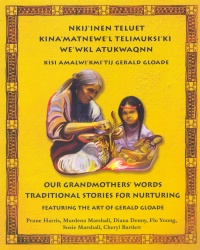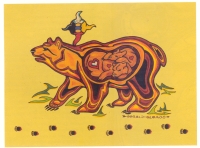| ________________
CM . . . . Volume XX Number 8 . . . . October 25, 2013


|
Nkij'inen Teluet: Kina'matnewe'l Telimuksi'ki We'wkl Atukwaqnn = Our Grandmothers' Words; Traditional Stories for Nurturing.
Prune Harris, Murdena Marshall, Diana Denny, Flo Young, Susie Marshall & Cheryl Bartlett. Featuring the art of Gerald Gloade.
Sydney, NS: Cape Breton University Press, 2013.
64 pp., pbk., $14.95.
ISBN 978-1-897009-80-2.
Subject Headings:
Child rearing-Folklore-Juvenile literature.
Pregnancy-Folklore-Juvenile literature.
Childbirth-Folklore-Juvenile literature.
Grandmothers-Folklore-Juvenile literature.
Micmac Indians-Folklore-Juvenile literature.
Folklore-Nova Scotia-Juvenile literature.
Grades 10 and up and Teachers' Resource / Ages 15 and up.
Review by Gail de Vos.
*** /4
|
| |
|

excerpt:
So I say, "You know son, only humans have this conflict."
"A rabbit does not have to think about how to act, he knows that he must eat and breathe, stay close to his family, be watchful sleep."
"A coyote does not have to think about how to act, she lives with her pack, she hunts, she runs and she plays."
"A bear does not have to think about how to act, all winter he sleeps in his cave, waking in the spring to walk and climb, eat and swim, before sleeping again the next winter."
"Animals do not have to think how to act, they feel how they must be, and that is how they live. But humans have to think about how to act. There are two levels of consciousness within them...let's call them two wolves, one is the good wolf and the other one is the bad wolf. They live inside each of us and are always fighting."
My grandson understands this, he thinks about it and after a while he says: "If they are fighting...who wins?"
So I tell him, "That is very simple, son, the one who wins is the one that you pay attention to more, the one that you feed the most. If you feed the negative wolf all the time that is the one that is going to win, if you feed the positive wolf then that one will overcome all the negative aspects of you, because the one thing that the good wolf has is love." (p. 14)
I am beginning this review with the excerpt above because there has been a great deal of discussion amongst folklorists lately about the origin of the story about the two fighting wolves. There have been claims that it is a traditional First Nations teaching story, but literary sources have been found for it that predate all of the other claims. I am not presenting it here to join in that discussion but to demonstrate how stories, traditional to the culture or not, are effectively and efficiently adapted to pass on wisdom and direction in oral, or in this case, written, stories.
 The 10 tales related in this collection are embraced by a frame story established in the prologue, "The Blessings of Life-when you are Pregnant." The prologue is preceded by the preface introducing the various storytellers and the illustrator responsible for the idea, content and design of the book itself. This brings me to the first minor quibble that I have about this book. The subject headings consistently label this book as "juvenile literature" but the prologue clearly states "The Grandmothers tell these stories to nurture Sali'j [a Mi'kmaw woman who is pregnant with her first child] so she can stay healthy throughout her pregnancy. Not only healthy in her body, but in her mind, in her emotions and in her spirit and they know that in this way the baby will be healthy too" (p. 9). The stories are definitely appropriate to be told, or even read, to young readers, but the intent of the book and its design sends a conflicting message. Not that the book does not deserve to be shared with children, it does. The beautiful illustrations by Gerald Gloade illuminate and delight the eye as do the page design and frames on each of the pages. The book is very beautiful as an object, but despite its shape and the fact that it contains stories, it should not be classified as a children's book. The stories are followed with "A Blessing for the New Born" and a circle graphic of Mi'kmaw Sacred Teachings: 7 Stages of Life with the 7 gifts. All of the content is presented in two languages, Micmac and English. Prune Harris created the book from the words of four grandmothers from the Mi'kmaw Nation of Eskasoni.
The 10 tales related in this collection are embraced by a frame story established in the prologue, "The Blessings of Life-when you are Pregnant." The prologue is preceded by the preface introducing the various storytellers and the illustrator responsible for the idea, content and design of the book itself. This brings me to the first minor quibble that I have about this book. The subject headings consistently label this book as "juvenile literature" but the prologue clearly states "The Grandmothers tell these stories to nurture Sali'j [a Mi'kmaw woman who is pregnant with her first child] so she can stay healthy throughout her pregnancy. Not only healthy in her body, but in her mind, in her emotions and in her spirit and they know that in this way the baby will be healthy too" (p. 9). The stories are definitely appropriate to be told, or even read, to young readers, but the intent of the book and its design sends a conflicting message. Not that the book does not deserve to be shared with children, it does. The beautiful illustrations by Gerald Gloade illuminate and delight the eye as do the page design and frames on each of the pages. The book is very beautiful as an object, but despite its shape and the fact that it contains stories, it should not be classified as a children's book. The stories are followed with "A Blessing for the New Born" and a circle graphic of Mi'kmaw Sacred Teachings: 7 Stages of Life with the 7 gifts. All of the content is presented in two languages, Micmac and English. Prune Harris created the book from the words of four grandmothers from the Mi'kmaw Nation of Eskasoni.
The stories delight the ear for, although they have been captured in print, there is a definite orality to them. These teaching stories paint pictures of a world of talking animals and birds, spirits, humans, and supernatural creatures. The world is not one of the past, but one that pulsates with continuity, birth and current concerns and issues. This is truly a gift for children that are being born into our complex, confusing and intricate contemporary world. My second minor quibble is that this gift is filled with typographical punctuation and spelling errors that should have been caught in the editing process. While these errors are not severe, they did take me out of the stories and away from the bequest that I was experiencing while immersed in the overall package and tales.
A book for public libraries and middle and high school library collections.
Recommended.
Gail de Vos teaches at the School of Library and Information Studies for the University of Alberta and San Jose State University. She is the author of nine books on storytelling and folklore.

To comment
on this title or this review, send mail to cm@umanitoba.ca.
Copyright © the Manitoba Library Association. Reproduction for personal
use is permitted only if this copyright notice is maintained. Any
other reproduction is prohibited without permission.
NEXT REVIEW |
TABLE OF CONTENTS FOR THIS ISSUE
- October 25, 2013.
AUTHORS |
TITLES |
MEDIA REVIEWS |
PROFILES |
BACK ISSUES |
SEARCH |
CMARCHIVE |
HOME |

 The 10 tales related in this collection are embraced by a frame story established in the prologue, "The Blessings of Life-when you are Pregnant." The prologue is preceded by the preface introducing the various storytellers and the illustrator responsible for the idea, content and design of the book itself. This brings me to the first minor quibble that I have about this book. The subject headings consistently label this book as "juvenile literature" but the prologue clearly states "The Grandmothers tell these stories to nurture Sali'j [a Mi'kmaw woman who is pregnant with her first child] so she can stay healthy throughout her pregnancy. Not only healthy in her body, but in her mind, in her emotions and in her spirit and they know that in this way the baby will be healthy too" (p. 9). The stories are definitely appropriate to be told, or even read, to young readers, but the intent of the book and its design sends a conflicting message. Not that the book does not deserve to be shared with children, it does. The beautiful illustrations by Gerald Gloade illuminate and delight the eye as do the page design and frames on each of the pages. The book is very beautiful as an object, but despite its shape and the fact that it contains stories, it should not be classified as a children's book. The stories are followed with "A Blessing for the New Born" and a circle graphic of Mi'kmaw Sacred Teachings: 7 Stages of Life with the 7 gifts. All of the content is presented in two languages, Micmac and English. Prune Harris created the book from the words of four grandmothers from the Mi'kmaw Nation of Eskasoni.
The 10 tales related in this collection are embraced by a frame story established in the prologue, "The Blessings of Life-when you are Pregnant." The prologue is preceded by the preface introducing the various storytellers and the illustrator responsible for the idea, content and design of the book itself. This brings me to the first minor quibble that I have about this book. The subject headings consistently label this book as "juvenile literature" but the prologue clearly states "The Grandmothers tell these stories to nurture Sali'j [a Mi'kmaw woman who is pregnant with her first child] so she can stay healthy throughout her pregnancy. Not only healthy in her body, but in her mind, in her emotions and in her spirit and they know that in this way the baby will be healthy too" (p. 9). The stories are definitely appropriate to be told, or even read, to young readers, but the intent of the book and its design sends a conflicting message. Not that the book does not deserve to be shared with children, it does. The beautiful illustrations by Gerald Gloade illuminate and delight the eye as do the page design and frames on each of the pages. The book is very beautiful as an object, but despite its shape and the fact that it contains stories, it should not be classified as a children's book. The stories are followed with "A Blessing for the New Born" and a circle graphic of Mi'kmaw Sacred Teachings: 7 Stages of Life with the 7 gifts. All of the content is presented in two languages, Micmac and English. Prune Harris created the book from the words of four grandmothers from the Mi'kmaw Nation of Eskasoni.